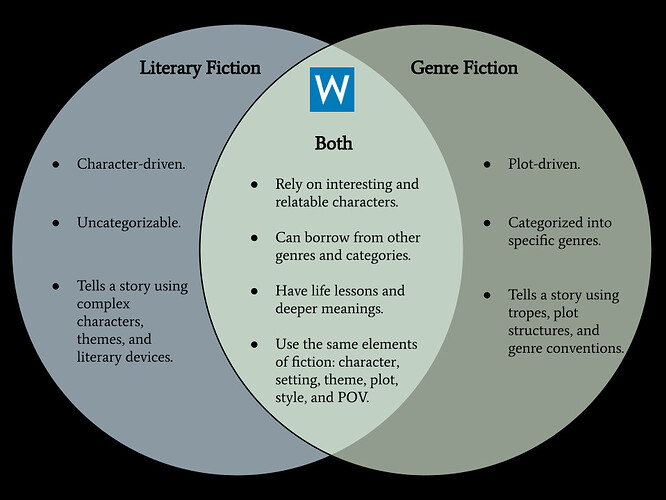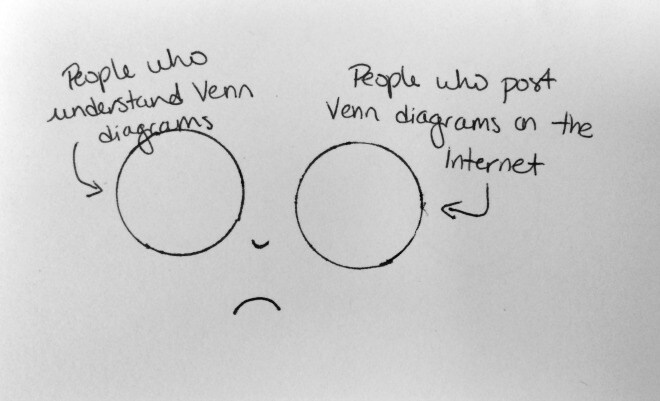And, rest assured, this new game I’m brainstorming will be degenerate genre trash whether or not I pull off my intended theme. It may also be art. Or not, depending on your definition.
You really had me going for a while there, and then you kept pushing on the gas long enough for me to understand your intent.
“Now all your family’s a pie and all the world merely mouths to eat that pie.”
-Wade
I like your version but it reminded me of another line in that play:
DEMETRIUS
Villain, what hast thou done?
AARON
That which thou canst not undo.
CHIRON
Thou hast undone our mother.
AARON
Villain, I have done thy mother.
You stepped in it? I think I did a face plant in it! ![]()
I found this really excellent article about literature that basically is my understanding of it all. It dissects things quite well. It’s worth a skim to the sci-fi section, at least.
➤ Literary Fiction vs. Genre Fiction
I guess I was using the misguided definition of literature being grounded in realism. Apparently, it’s called literary fiction.
“Literary fiction is a category of novels that emphasize style, character, and theme over plot.”
My bad. I blame pre-internet English teachers. ![]()
This seems like a nice and nuanced approach; my apologies for trying to cast things as black and white!
I actually have an entire talk scheduled in this year’s Narrascope about puzzles which enforce narrative themes!
I (biased) personally think that theme is the big ticket item here. As @DeusIrae said, universal experiences are what are usually thought of as “the human condition” and narrative theme is what turns hyperspecific situations into universally resonanting messages.
If you write something in the way @AmandaB did with her aforementioned game, Of Their Shadows Deep, with a strong core and theme like she did…then you can make the game about going into a magical forest where riddle answers are objects with the memories of words in them (a very specific and fantasy “genre fiction” scenario) also contain a poignant message about the “human condition” of going to desperate and ultimately fruitless (yet worthwhile) lengths to save the shadow of someone you love and are ultimately losing.
Theme’s a powerful thing.
This is not exactly a synopsis of Rudolph Wurlitzer’s Nog—more like a synopsis of one of its chapters. But I get your point.
Somewhat amusingly, the entire point of that article is to categorize what it claims is uncategorizable, proving itself wrong.
It also seems to argue that magical realism is genre fiction, that Haruki Murakami writes magical realism, but that Kafka on the Shore is somehow not genre fiction.
The first thing that I have noticed about that Venn diagram was indeed the irony of categorizing some fiction as literary and then adding the property uncategorizable under it.
To be fair the article HAL9000 linked to explained that literary fiction is not categorizable into further subcategories. Still I think it is a weak point in the treatment.
I found the article to be an interesting bridge between the traditional, perhaps elitist, view of literary fiction (what I was calling literature, beforehand) and that of genre writing that incorporates literary qualities. The quality of realism is the sticking point for the older crowd, I think, when it comes to saying whether something fits under the literary fiction umbrella. It’s like, how would you categorize a book like Finding Forrester? That’s where that uncategorizable element comes from. That’s what is traditionally accepted as literary fiction; something that is primarily a snapshot of humanity, essentially, without any distractions of the fantastical.
However, as Brian pointed out, there are many works that are considered great literature about the human condition not based in a realistic world, thus what makes those literature and not genre writing? The article seems to rectify this by suggesting that the fantastical parts are merely a backdrop and not the focus at all of the story. Almost as if you can remove the fantastic and still the story would remain intact. That’s something I don’t think you can say with most genre writing.
Then it cleverly bridges the two worlds by suggesting that both sides compromise a bit of what makes them unique, offering a merged definition. So when I say that science fiction is not literary fiction, it just means that it doesn’t resemble real life and that it typically relies on the tropes of sci-fi to prop up the story. If you removed the science trope part of it, would it still hold its own? Probably not as much. It’s not Finding Forrester, but it also doesn’t mean that it doesn’t tackle the human condition in a satisfying and profound manner. Whenever I heard the word literature, I was always under the impression that it was only that of realism and personal struggles. Now I have a slightly new appreciation and understanding. There definitely is a grey area that I never fully appreciated before.
I hope I’m still on topic with what I’m saying here.
As a side note, I used to coach sports. Sometimes, I encourage people to be their best by challenging them. In these forums, I challenge ideas (not physical ability obviously), but challenging someone always comes at the expense of their comfort level. Just putting that out there. Anyway, I just gotta say that I’ve really enjoyed this topic. It’s forced me to contemplate and reconsider quite a bit. I’ve definitely been pushed out of my comfort zone by the excellent points being made all around.
(An aside:)
Brilliant tweet I saw once, author unremembered…
Lucifer is the Boba Fett of Christianity. In canon, he didn’t do much besides fall in a pit, but then fan-fiction made a big deal out of him."
Brian, I noted that you kept out of your provocative post Dante’s Commedia and Virgil’s Enead and Tasso’s Orlando Furioso; no need of being wary of the proverbial Italian argumenting, trust me… ![]()
Best regards from Italy,
dott. Piergiorgio.
On a more important topic, why is it that people who don’t understand Venn diagrams keep using them?
How was it misused?
Venn diagrams divide a universal set into subsets and express the relationships between those sets. This diagram expresses the common and different attributes of two categories. These are distinct things. As drawn, the diagram indicates there is a huge overlap between genre and literary fiction, i.e., many many works that fall in both categories. My understanding is that wasn’t the author’s intent.
Edit: The author is not alone in this. Popular culture has desecrated the poor ol’ Venn diagram.
Ohhh, so there should be examples of works listed in the diagram, instead of attributes of each category being listed?
Well, you can choose whatever you want, just as long as you remain consistent. The author here can’t decide if the desired grouping is sets of works, or sets of attributes. If he chose one, it’d be a fine diagram, but it would also probably render the diagram pretty meaningless. What he really wants is a table with three columns, labeled “attributes of literary fiction”, “attributes of genre fiction”, and “attributes shared by both”.
Okay I’ll shut up now.
On the rare occasions that I read non-genre fiction, I usually think “but nothing happens!”
The ‘traditional’ plot of SF is “The protagonist (The Competent Man) is placed in a difficult situation. What does he do to overcome it?”. Philip K Dick’s stories tend to be “The protagonist is placed in a difficult situation. How does he feel about it?”.

